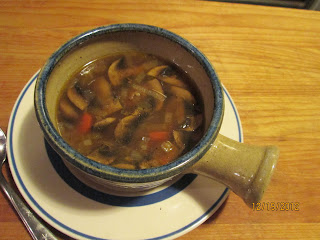 I was introducedto this bread by Rethie Foster when I interviewed her for my February 2002cooking column for the Abilene Reflector-Chronicle. Here’s what I said in therecipe header, “Thisis a somewhat complicated recipe but well worth the effort! It belongs in the 'sourdough' category andbegins with an old-fashioned sponge starter. Rethie discovered this bread inthe newspaper and it became a favorite.”
I was introducedto this bread by Rethie Foster when I interviewed her for my February 2002cooking column for the Abilene Reflector-Chronicle. Here’s what I said in therecipe header, “Thisis a somewhat complicated recipe but well worth the effort! It belongs in the 'sourdough' category andbegins with an old-fashioned sponge starter. Rethie discovered this bread inthe newspaper and it became a favorite.”Old Milwaukee Rye Bread Yield: 4 loaves
1. Combine the yeast and water in a largebowl.
 |
| This is what the starter looks like. |
Rye Bread
1. Stir down the sponge.
 |
| The development of bubbles in the yeast mixture indicates that is has been activated. |

7. Add 2 cups of all-purpose flour and blendwith a wooden spoon. (Or, mix with thepaddle attachment of a counter-style mixer.)

9. Add more flour, about 2 tablespoons at atime, until the dough has a proper pliable and workable consistency (it shouldlose it’s stickiness but not be dry). Turn the dough out onto a lightly flouredboard and continue kneading about 6 minutes or longer. Knead and beat doughabout 10 minutes. When ready, dough should weigh about 3½ pounds. (I insert the kneading attachment rightbefore beginning this step.)
 |
| The kneaded dough has pulled away from the sides of the bowl . |
 |
| Kneaded dough has just been added to the bowl. |
 |
| This is what is looks like after an hour! |
 |
| Loaves have just been added to the bread pans. |
 |
| Slashing the raised dough helps control splitting during the baking process. |

*Flour amounts varydue to weather conditions. In very humid weather, yeast recipes often requiremore flour because the extra moisture in the air keeps the dough soft. Theprotein content of the flour can cause variables.
Recipe without photos:
1. Combine the yeast and water in a largebowl.
Rye Bread
1. Stir down the sponge.
*Flour amounts varydue to weather conditions. In very humid weather, yeast recipes often requiremore flour because the extra moisture in the air keeps the dough soft. Theprotein content of the flour can cause variables.
 The elves have been busy making Christmaspopcorn . . . or maybe it was a few of the nutcrackers that seem to invade our house each holiday season. Nevertheless, sacks of cinnamon popcorn are now ready for delivery. And, the little helpers even attachedrecipes to the sacks! Just wished that they had washed the dishes when theywere through!
The elves have been busy making Christmaspopcorn . . . or maybe it was a few of the nutcrackers that seem to invade our house each holiday season. Nevertheless, sacks of cinnamon popcorn are now ready for delivery. And, the little helpers even attachedrecipes to the sacks! Just wished that they had washed the dishes when theywere through!






 Not much time for kitchen duties yesterdayso I wanted something I could quickly assemble and put in the slow cooker. Wealso had some leftover roast so this is what I came up with – Slow Cooker Beef,Barley and Mushroom Soup. It was kind of like French onion soup but a lot morehearty!
Not much time for kitchen duties yesterdayso I wanted something I could quickly assemble and put in the slow cooker. Wealso had some leftover roast so this is what I came up with – Slow Cooker Beef,Barley and Mushroom Soup. It was kind of like French onion soup but a lot morehearty!
